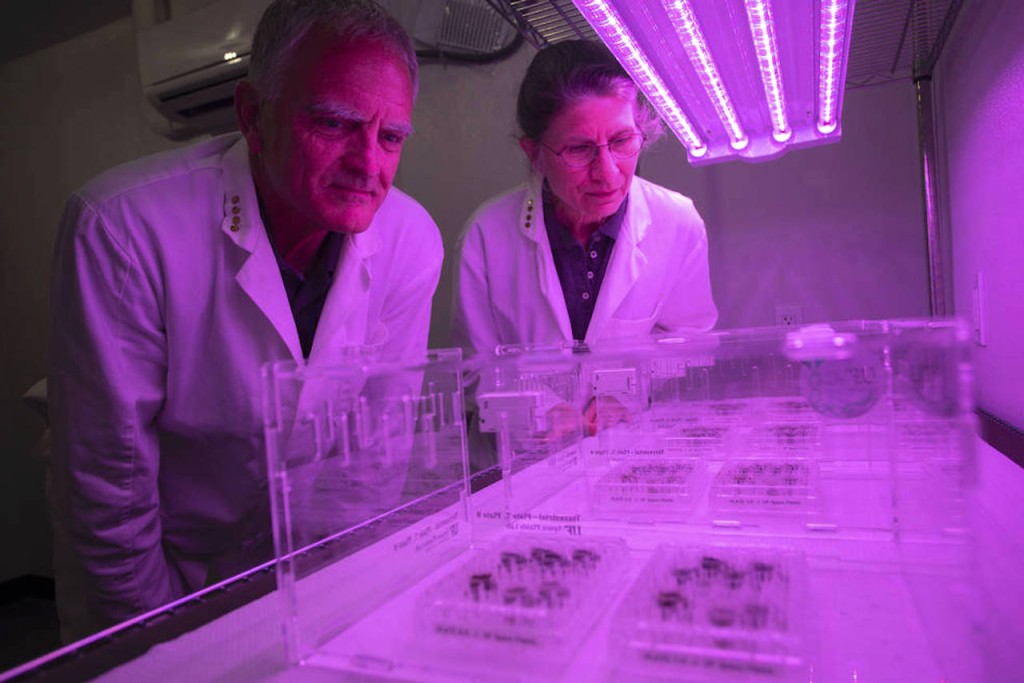Scientists take the first step along the road to extraterrestrial gardening by learning we can grow plants in lunar soil.
By Larry Hodgson
Fifty years after the first samples of moon dirt and dust (“regolith”) were brought back to earth by the various Apollo missions, researchers at the Space Plants Lab at the University of Florida have tried using the product to grow plants for the first time. They published their report on May 12, 2022.
This came after years of quarantine in case some sort of deadly lunar microbe might be hitching a ride in the particles. Then other scientists carried out endless other studies on the composition of lunar rocks and dust, their history and much more. But this is the first that a horticultural team used it.
According to NASA Administrator Bill Nelson, “This research is critical to NASA’s long-term human exploration goals as we’ll need to use resources found on the Moon and Mars to develop food sources for future astronauts living and operating in deep space.”
Lunar Soil: A Precious Commodity
The tests were done by the team of Dr. Anna-Lisa Paul and Dr. Rob Ferl, professors in the Horticultural Sciences Department at the University of Florida, Gainesville.
The plant tested is a fast-growing annual called thale cress (Arabidopsis thaliana), a common laboratory plant in the cabbage family long used as a model organism for research into plant biology.
Since lunar soil is very rare and precious, the researchers had to apply years in advance and only received a small amount. That meant the experiment had to be on a small scale.
Lunar regolith is largely small pieces of basaltic rock with sharp, ragged, cutting surfaces. A lot like volcanic ash. Most of the minerals it contains occur on earth, but also some don’t. That’s the case, for example, of minerals that immediately oxidize on Earth, but remain intact in space and on the Moon.
The scientists dusted about 1 teaspoon of lunar regolith into tiny growth tubes alongside a control group that used an earth-based soil of similar makeup: volcanic ash! Then they added the seeds. They placed the seedling trays in a growth chamber under good light and high humidity. They also supplied them with water and a dilute nutrient solution. In other words, the team gave them much the same care you would to any seeds you sow indoors.
Then they waited.
Quick Results
But not for long. There was already germination in just 2 days.
The scientists were thrilled by the results, though, as every seed germinated. That might seem like a small detail, but it was of critical importance. It proved there was nothing inherently bad about lunar regolith when it came to growing plants: a vital piece of information.
And further results were also encouraging. Through the early stages of growth, when the young plants largely depend on minerals and glucids found in the original seed, they grew perfectly well.
Then by the sixth day, as their roots expanded, the moon regolith plants started lagging. In spite of nutrient support, lunar plants struggled: their growth rate was slower, they suffered from stress-related depigmentation, leaves did not develop normally, roots were stunted, etc.
Still, they did grow and they were able to use minerals found in the regolith. Essentially, the plants were reacting much as they would to growing in other harsh environments, such as when the soil has too high a concentration of salt or heavy metals.
And they bloomed, or at least started to. After 20 days, just at the plants were about to flower, the team harvested and dried the plants. Then ground them up for analysis.
Interestingly, the regolith (lunar soil) reacted to its use as a substrate for growing plants too. There were changes to its texture following exposure to water, air and biological processes, including contact with microbes.
Ready to Plant a Moon Garden?
No, we’re not yet ready to grow fresh vegetables in lunar soil. A bit of tweaking will be needed before humans will be able to do that, but it’s now sure it will be possible. The team now hopes to go on to develop ways of actually gardening in lunar regolith, paving the way for future astronauts to someday grow more nutrient-rich plants on the Moon, or ones that will even thrive in deep space.
With upcoming moon missions and eventually even trips to Mars being studied, farming in space will be necessary. And one day space travelers will certainly be enjoying Moon salads and Mars tomatoes . . . based on information gathered from this experiment.
You can find more information about the program in this report: Scientists Grow Plants in Lunar Soil.

